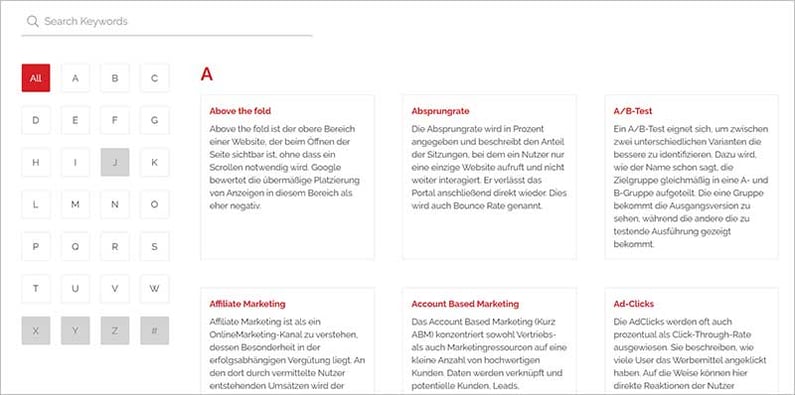HubSpot: Create dynamic website pages with HubDB
Would you like to maintain and manage your structured content on your website easily and effectively? Then HubDB is just right for you. With HubDB...
5 min read
 Dorothea Benner
|
Oct 01, 2024 - Last updated Apr 29, 2025
Dorothea Benner
|
Oct 01, 2024 - Last updated Apr 29, 2025

You work with HubSpot and already use the HubSpot CMS from the Content Hub for your website. You may be familiar with the HubSpot HubDB tables/databases, and even if you know what HubDB is and what it can be used for, you can't really imagine what it looks like.
I'll be happy to show you how it might look in practice using a few live examples we have implemented for our customers.
And in case you don't yet know what HubDB is and what you can use it for, feel free to read my blog post; HubSpot: Create dynamic website pages with HubDB.
Here you can see a HubDB table, with rows, columns and fields. The columns can be of different types, such as rich text, URL, image, etc. There are 15 types in total.

Next, I quickly created a template (in this case a module) for a references website page, as below:

I have selected 3 columns from the HubDB table; name, image and description.
The query shown here is only intended to illustrate the connection between the table and the dynamic playback of content on a web page.
This is what the result looks like without styling:

Let me show you some examples of websites where the web content is generated with the help of HubDB to demonstrate how you can use HubDB. These examples are some of the projects we have realized for our customers.

Former Partner page from Fincite | Digital Investment Platform
This image comes from a former website that used HubDB for its partner directory, including filter functionality. For your information, Fincite has not used HubSpot for its website since 2025.
In this case, the HubDB table consists of the following columns or column types::
ID | Name | Partner type (Filter) | Website (URL) | Logo (Image) | Description (Rich-Text)
If your organization works with a community of partners, HubDB is a great way to make your partners more discoverable and help your customers and prospects identify the right partners to meet their needs.
The structured and dynamic presentation of partner information in HubDB makes collaborations more transparent and makes working together more effective. This way, your customers can find the right partners for their needs and benefit from the many advantages of the partnerships.
Like the following images from examples, this example is a possibility of many others based on HubDB.
Events are extremely popular on B2B websites and have specific requirements that traditional pages or blog posts often cannot fulfill. The date is particularly important for events, especially when it comes to registrations.
Past events need to be handled differently than upcoming ones, and often there are multiple speakers, registration links, and the option to view events later. HubDB makes managing all of these aspects much easier. Adding and updating event information, speakers, and registration links is quick and straightforward. It all happens only in the HubDB table, and the content is displayed dynamically on the event website.
You also have the flexibility to decide how and where events are presented, both before and after they have taken place. Last but not least, you can quickly customize the destination URL or content, such as a link to the recording or a landing page for access after the event.

Event page von IPA (ImmunoPrecise Antibodies) | Biotherapeutic Intelligence
Stay up-to-date with the upcoming events on the website, thanks to filters.

Same events displayed on the front page from IPA (ImmunoPrecise Antibodies) | Biotherapeutic Intelligence
In this example, the data from the same Events table in the HubDB is used with a different design. You only need to update one table to change the contents across all pages simultaneously.

Event page from znt-Richter | Innovative Software Solutions
Another example of your events is when you want to draw attention to your participation in a trade fair.
In the B2B sector, the company website is one of the most frequently visited pages. The interest in who is behind a company is of great importance to many. It is about first impressions, trust and credibility.
And a few faces to go with it always look good.
HubDB is ideal for such content because it is easy to edit and update when something changes. Also, the key data, such as name and position, social media links, about each member are usually almost the same and can be easily converted into a table.
Such a table is also a great way for listing contacts for different departments – just add their phone number and email address and you're done.

Company page with Team from Phocus DC | Agentur für Unternehmensberatung
You can see a classic list of employees here on the Phocus Direct Communication team website. The presentation and styling of the data records remain consistent, if available (for example, if you do not want the LinkedIn profile link to be displayed, simply leave the corresponding column in this row in the table blank for this employee).

Company page from IPA (ImmunoPrecise Antibodies) | Biotherapeutic Intelligence
Here, you see a clear arrangement of leadership executives with a bio linked to a single dynamic page for each person, automatically created based on additional content in the HubDB table. HubDB also controls the URL of these dynamically created pages.
Another way to use this great tool is to search for job offers. The filter function offers a wide range of data record searches and all structured data is clearly arranged in one place, making editing, updating and publishing super easy.
Deactivated offers remain in the table and can be reactivated later with minor adjustments. An automatic redirection for all no longer existing dynamic pages can also be set up.

Careers page with job offers from EurA - Innovationsberatung für Ihren Erfolg
As you can see here, job offers can be sorted by location, as is the case with EurA. After clicking on a location, an overview of the vacancies appears first with a short description, see below.

Pop-up with short job description from EurA - Innovationsberatung für Ihren Erfolg
After that, it automatically goes to the generated details page of the job offer. The same principle can also be applied to locations, as you can see below.

Locations from EurA - Innovationsberatung für Ihren Erfolg
By the way: several HubDBs can also be linked together, so that recurring content only has to be entered once (as in this example. The HubDB with the locations is also used for the careers pages. The contents of these (e.g. address) are simply linked in the job HubDB!
A key requirement of a resource library is to provide various resources, such as blogs, vlogs, white papers, e-books, and more, and to link these to the actual content.
Since a site like this grows over time, interested visitors must be provided with a user-friendly search function. If this is impossible, users may give up searching, and some resources remain undiscovered.
Managing all your resources at the page level can quickly become complicated and time consuming. Use a HubDB table, and your collection of contents can be easily and effectively managed. 
Resources page from Phocus DC | Agentur für Unternehmensberatung
The image shows a resource web page with a user-friendly search function organized by media type and topic.
A glossary web page is becoming more and more popular, so it can increase visibility in search engines, improve user experience and retention time, and trump internal links.
HubDB is perfect for such data. Below you can see an example of this.
A search field has been added for a better User Experience.

Currently Offline - Glossar y page from Phocus DC | Agentur für Unternehmensberatung
Conclusion:
HubDB is a great tool. It can be used in a variety of ways and is easy to keep up-to-date, especially with regard to multilingual web design.
---
You want to use HubDB and need help with the implementation? Here we are!
What you absolutely must consider when planning and creating HubDB(s) in HubSpot, and the best way to proceed, will be explained.
Image source: AdobeStock © baranq
Share this article

Would you like to maintain and manage your structured content on your website easily and effectively? Then HubDB is just right for you. With HubDB...

The HubSpot Content Hub combines the CMS (Content Management System) and the CRM (Customer Relationship Management) in one system or platform. And...

A website is more than a beautiful web design. In addition to a marketing functionality, it also has a communication task. With HubSpot's CMS, with...